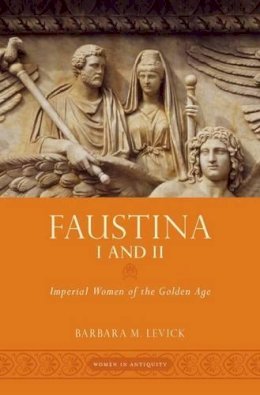
Stock image for illustration purposes only - book cover, edition or condition may vary.
Faustina I and II
Barbara M. Levick
€ 142.69
FREE Delivery in Ireland
Description for Faustina I and II
A learned study of a mother and daughter, both the wives of emperors, and their importance in the golden age of the Roman Empire Series: Women in Antiquity. Num Pages: 272 pages, 12 illus, 2 maps. BIC Classification: HBLA; HBLA1; JFSJ. Category: (G) General (US: Trade). Dimension: 243 x 165 x 25. Weight in Grams: 488.
The elder Faustina (c. 97 - 140 AD) was the wife of Antonius Pius and the aunt of Marcus Aurelius, and her more prominent daughter, Faustina II (130 - 175), the wife of Marcus Aurelius and the mother of Commodus. Bearing the same name, and both the wives of rulers, these women shed valuable light on the role of imperial women in in what is often considered the golden age of the Roman Empire. Barbara Levick's Faustina I and II highlights the importance of these women to the internal politics of the Empire during this period and shows how they are links in a chain of elite Roman women for whom varying levels of recognition and even power were available. The Faustinae, as they are jointly called, come between the discreet Matidiae, the discreetly manipulative Plotina (Trajan's women), the philosophical Sabina (Hadrian's wife) and in the Severan dynasty Julia Domna, who has had a very high profile. In assessing their place in this chain, Levick will examine especially Faustina II's deep involvement in palace politics, her enhancement of her mother's position, and her possible role in the revolt of Avidius Cassius (175). This book will also bring together and display the material evidence for their lives and legacies. There is an abundance of inscriptions and coins that provide firm evidence for their public status in Rome, Italy, and various parts of the Empire. Portraiture is also examined, in particular to see how much Faustina I and II were identified by artists, and how close a precedent Faustina II was for Domna, as their titulature suggests she was. Overall, this learned study carefully balances the evidence to explain how these women were at once continuators of a dynasty and emblems of the ideals of Roman marriage, and yet also the target of rumors of infidelity and treason, with reputations that are often in stark contrast to those of their husbands.
Product Details
Publication date
2014
Publisher
Oxford University Press Inc United States
Number of pages
272
Condition
New
Series
Women in Antiquity
Number of Pages
272
Format
Hardback
Place of Publication
New York, United States
ISBN
9780195379419
SKU
V9780195379419
Shipping Time
Usually ships in 15 to 20 working days
Ref
99-2
About Barbara M. Levick
Barbara M. Levick is Emeritus Fellow and Tutor in Literae Humaniores, St. Hilda's College, University of Oxford.
Reviews for Faustina I and II
Addressing the question whether a biography of the Faustinae is feasible in the light of the casual and often tendentious remarks in the literary sources that - as is common in the study of ancient women - did not focus on them, and the official nature of the numerous statues, inscriptions and coins, she expresses the aim of assessing the relative power and recognition of the Faustinae in comparison to the empresses who preceded and succeeded them. ... Taking a broad scope, Levick synthesizes a wide range of sources and studies not only on the Faustinae but also on the Antonine emperors, their ancestors and families and their predecessors with their wives and families. Her vast knowledge of prosopography allows her to knit them all together. ... Levick's aim has surely been reached.
Bryn Mawr Classical Review
Bryn Mawr Classical Review
